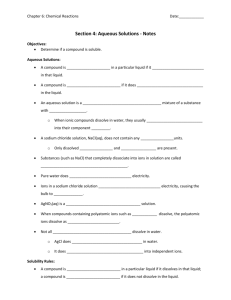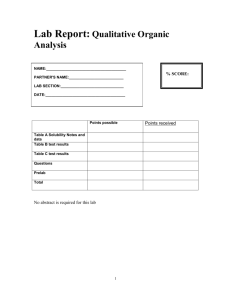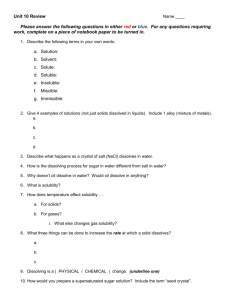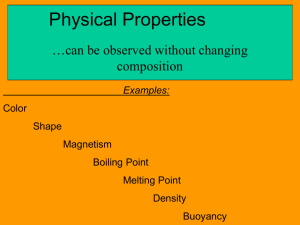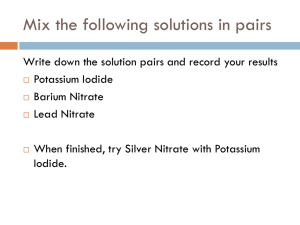oxidation hcl
advertisement
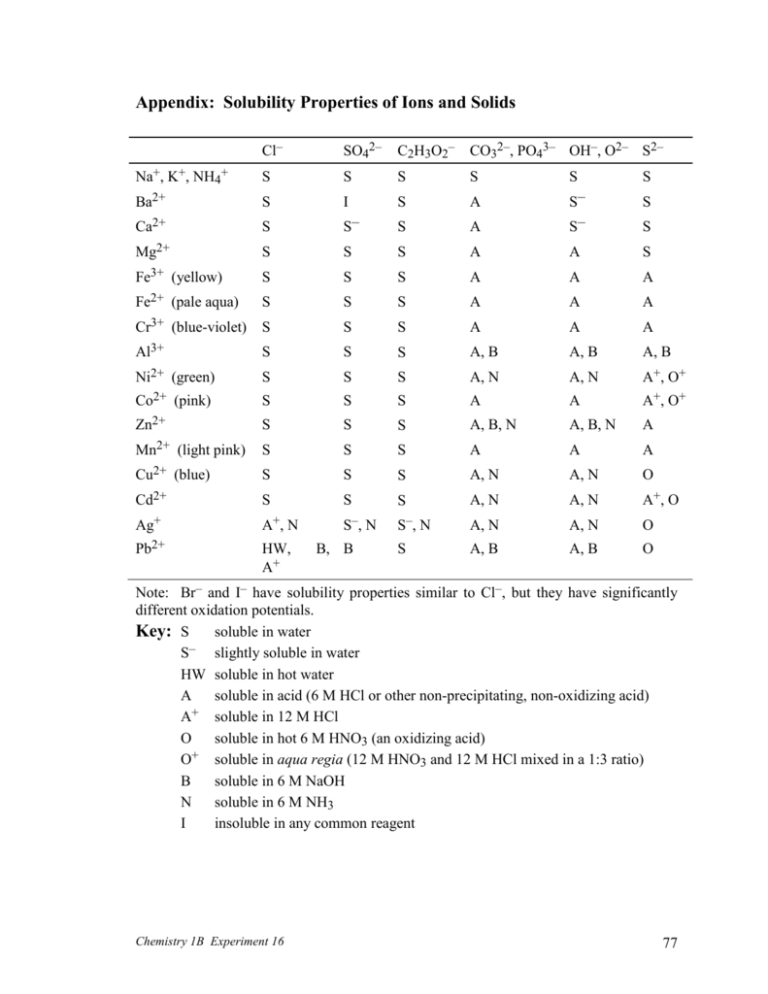
Appendix: Solubility Properties of Ions and Solids Cl– SO42– C2H3O2– CO32–, PO43– OH–, O2– S2– Na+, K+, NH4+ S S S S S S Ba2+ S I S A S Ca2+ S S– S A S– S– Mg2+ S S S A A S Fe3+ (yellow) S S S A A A Fe2+ (pale aqua) S S S A A A Cr3+ (blue-violet) S S S A A A Al3+ S S S A, B A, B A, B Ni2+ (green) S S S A, N A, N A+, O+ Co2+ (pink) S S S A A A+, O+ Zn2+ S S S A, B, N A, B, N A Mn2+ (light pink) S S S A A A Cu2+ (blue) S S S A, N A, N O Cd2+ S S S A, N A, N A+, O Ag+ A+, N S–, N S– , N A, N A, N O Pb2+ HW, A+ S A, B A, B O B, B S Note: Br– and I– have solubility properties similar to Cl–, but they have significantly different oxidation potentials. Key: S soluble in water S– slightly soluble in water HW soluble in hot water A soluble in acid (6 M HCl or other non-precipitating, non-oxidizing acid) + A soluble in 12 M HCl O soluble in hot 6 M HNO3 (an oxidizing acid) + O soluble in aqua regia (12 M HNO3 and 12 M HCl mixed in a 1:3 ratio) B soluble in 6 M NaOH N soluble in 6 M NH3 I insoluble in any common reagent Chemistry 1B Experiment 16 77 Interpreting the table of solubility properties S The solubility in water is at least 0.1 M. For some compounds, shaking and stirring will be necessary. Compounds that are soluble in water are also soluble in acids, as long as the anion part of the acid does not precipitate with the cation part of the compound that you are trying to dissolve. – S Some of the compound will dissolve in water, but its solubility is less than 0.1 M. HW The compound will not dissolve in cold water, but its solubility in hot (near boiling) water is at least 0.1 M. A The compound will not dissolve in pure water, but, in a 6 M solution of strong acid, its solubility is at least 0.1 M. An acid-base reaction is involved. Notice that most of the compounds in the table that are labeled with an A contain the conjugate bases of weak acids. When choosing the strong acid, make sure that the anion of the acid does not precipitate with the cation of the compound that you are trying to dissolve. For example, Fe(OH)3 is soluble in strong acid due to the acid-base reaction: Fe(OH)3 (s) + 3 H3O+ (aq) Fe3+ (aq) + 6 H2O (l) Ag2O is soluble in strong acid due to the acid-base reaction: Ag2O (s) + 2 H3O+ (aq) 2 Ag+ (aq) + 3 H2O (l) Why would you need to use HNO3 instead of HCl in the case of Ag2O? A+ When trying to react an oxide (rather than a hydroxide) with an acid, vigorous shaking and stirring and maybe even warming in a hot water bath will be necessary. The compound will not dissolve in pure water or in 6 M acids, but, in a 12 M HCl solution, its solubility is at least 0.1 M. A complex ion formation reaction is involved. Ag+ and Pb2+ form stable complex ions with chloride ions. Vigorous shaking and stirring will be necessary. Be careful! For example, PbCl2 is soluble in excess 12 M HCl due to formation of a complex ion: PbCl2 (s) + 2 Cl– (aq) PbCl42– (aq) O The compound will not dissolve in pure water, nor will it dissolve in acids via ordinary acid-base reactions, but it will react with hot 6 M HNO3 to form soluble ions. You will need to boil the solution. Use a boiling chip! An oxidationreduction reaction is involved. Notice that most of the compounds in the table that are labeled with an O are sulfides. The sulfide ions (S2–) in these compounds will be oxidized to elemental sulfur (S). For example, while CuS is insoluble in water and even in acids, it can be converted to soluble Cu(NO3)2 by oxidation of its sulfide ion: O+ B 3 CuS (s) + 2 NO3– (aq) + 8 H+ (aq) 3 Cu2+ (aq) + 3 S (s) + 2 NO (g) + 4 H2O (l) This is similar to O, except that the oxidizing reagents must be more concentrated for the oxidation-reduction reaction to go to completion. Hot 12 M HNO3 is needed in combination with 12 M HCl, which serves as an additional source of hydronium ions. The compound will not dissolve in pure water, but, in a 6 M solution of NaOH, its solubility is at least 0.1 M. A complex ion formation reaction is involved. Al3+, Chemistry 1B Experiment 16 78 Zn2+, and Pb2+ form stable complex ions with hydroxide ions (OH–). Vigorous shaking and stirring will be necessary. For example, Zn(OH)2 is soluble in NaOH due to formation of a complex ion: Zn(OH)2 (s) + 2 OH– (aq) Zn(OH)42– (aq) N The compound will not dissolve in pure water, but, in a 6 M solution of NH3, its solubility is at least 0.1 M. A complex ion formation reaction is involved. Ni2+, Zn2+, Cu2+, Cd2+, and Ag+ form stable complex ions with ammonia (NH3). Vigorous shaking and stirring will be necessary. For example, Zn(OH)2 is also soluble in NH3 due to the formation of another complex ion: Zn(OH)2 (s) + 4 NH3 (aq) Zn(NH3)42+ (aq) + 2 OH– (aq) I The compound will not dissolve or react in any reagent available in the laboratory. Note: The table can be used to predict the solubilities of dry solids in the various reagents. If you want to test a solid that has precipitated from a solution, you must first centrifuge the mixture and pour off the liquid. Chemistry 1B Experiment 16 79
